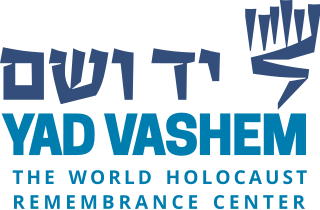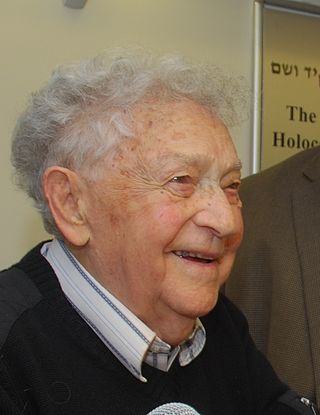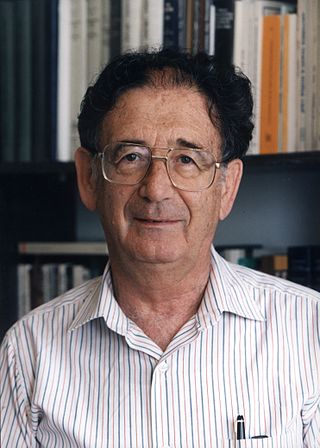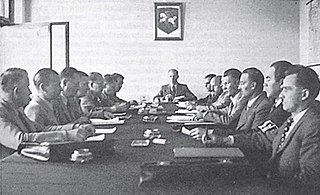Related Research Articles

Yad Vashem is Israel's official memorial to the victims of the Holocaust. It is dedicated to preserving the memory of the Jews who were murdered; echoing the stories of the survivors; honoring Jews who fought against their Nazi oppressors and gentiles who selflessly aided Jews in need; and researching the phenomenon of the Holocaust in particular and genocide in general, with the aim of avoiding such events in the future. Yad Vashem's vision, as stated on its website, is: "To lead the documentation, research, education and commemoration of the Holocaust, and to convey the chronicles of this singular Jewish and human event to every person in Israel, to the Jewish people, and to every significant and relevant audience worldwide."

Maly Trostenets is a village near Minsk in Belarus, formerly the Byelorussian Soviet Socialist Republic. During Nazi Germany's occupation of the area during World War II, the village became the location of a Nazi extermination site.

The Black Book of Soviet Jewry or simply The Black Book, also known as The Complete Black Book of Russian Jewry, is a 500-page document compiled for publication by Ilya Ehrenburg and Vasily Grossman originally in late 1944 in the Russian language. It was a result of the collaborative effort by the Jewish Anti-Fascist Committee (JAC) and members of the American Jewish community to document the anti-Jewish crimes of the Holocaust and the participation of Jews in the resistance movement against the Nazis during World War II. The 1991 Kyiv edition of The Black Book was subtitled The Ruthless Murder of Jews by German-Fascist Invaders Throughout the Temporarily-Occupied Regions of the Soviet Union and in the German Nazi Death Camps established on occupied Polish soil during the War 1941–1945.

Righteous Among the Nations is a title used by Yad Vashem to describe people who, for various reasons, made an effort to assist victims, including Jews, who were being exterminated by Nazi Germany during the Holocaust. The term originates from the concept of ger toshav, a legal term used to refer to non-Jewish observers of the Seven Laws of Noah.

The Destruction of the European Jews is a 1961 book by historian Raul Hilberg. Hilberg revised his work in 1985, and it appeared in a new three-volume edition. It is largely held to be the first comprehensive historical study of the Holocaust. According to Holocaust historian, Michael R. Marrus, until the book appeared, little information about the genocide of the Jews by Nazi Germany had "reached the wider public" in both the West and the East, and even in pertinent scholarly studies it was "scarcely mentioned or only mentioned in passing as one more atrocity in a particularly cruel war".

Slutsk is a town in Minsk Region, Belarus. It serves as the administrative center of Slutsk District, and is located on the Sluch River 105 km (65 mi) south of the capital Minsk. As of 2024, it has a population of 60,056.

Yitzhak Arad was an Israeli historian, author, IDF brigadier general and Soviet partisan. He also served as Yad Vashem's director from 1972 to 1993, and specialised in the history of the Holocaust.

Yehuda Bauer is a Czech-born Israeli historian and scholar of the Holocaust. He is a professor of Holocaust Studies at the Avraham Harman Institute of Contemporary Jewry at the Hebrew University of Jerusalem.

The Provisional Government of Lithuania was an attempted provisional government to form an independent Lithuanian state in the last days of the first Soviet occupation and the first weeks of the German occupation of Lithuania during World War II in 1941.
The Encyclopedia of the Holocaust (1990) has been called "the most recognized reference book on the Holocaust". It was published in an English-language translated edition by Macmillan in tandem with the Hebrew language original edition published by Yad Vashem, the Holocaust Remembrance Authority in Israel. All its contributors are reputable Holocaust scholars and academics. Although the encyclopedia is easy to read and use and contains no disturbing pictures, it is not recommended for users younger than high school age.
Holocaust trivialization refers to any comparison or analogy that diminishes the scale and severity of the atrocities that were carried out by Nazi Germany during the Holocaust. The Wiesel Commission defined trivialization as the abusive use of comparisons with the aim of minimizing the Holocaust and banalizing its atrocities. Originally, holocaust meant a type of sacrifice that is completely burnt to ashes; starting from the late 19th century, it started to denote extensive destruction of a group, usually people or animals. The 1915 Armenian genocide was described as a "holocaust" by contemporary observers.
The anti-Jewish violence in Central and Eastern Europe following the retreat of Nazi German occupational forces and the arrival of the Soviet Red Army – during the latter stages of World War II – was linked in part to postwar anarchy and economic chaos exacerbated by the Stalinist policies imposed across the territories of expanded Soviet republics and new satellite countries. The anti-semitic attacks had become frequent in Soviet towns ravaged by war; at the marketplaces, in depleted stores, in schools, and even at state enterprises. Protest letters were sent to Moscow from numerous Russian, Ukrainian and Belarusian towns by the Jewish Anti-Fascist Committee involved in documenting the Holocaust.
The Holocaust in Belarus refers to the systematic extermination of Jews living in the Byelorussian Soviet Socialist Republic during its occupation by Nazi Germany in World War II. It is estimated that roughly 800,000 Belarusian Jews were murdered during the Holocaust. However, other estimates place the number of Jews killed between 500,000 and 550,000.

The Holocaust in Ukraine was the systematic mass murder of Jews in the Reichskommissariat Ukraine, the General Government, the Crimean General Government and some areas which were located to the East of Reichskommissariat Ukraine, in the Transnistria Governorate and Bessarabia, Northern Bukovina and the Hertsa region and Carpathian Ruthenia during World War II. The listed areas are currently parts of Ukraine.

Krupki is a town in Minsk Region, Belarus. It serves as the administrative center of Krupki District. As of 2024, it has a population of 8,410.
David Bankier was a Holocaust historian and head of the International Institute for Holocaust Research at Yad Vashem.
Livia Rothkirchen was a Czechoslovak-born Israeli historian and archivist. She was the author of several books about the Holocaust, including The Destruction of Slovak Jewry (1961), the first authoritative description of the deportation and murder of the Jews of Slovakia.
Shmuel Krakowski, Samuel Krakowski or Stefan Krakowski was an Israeli historian specializing in the Holocaust in Poland. After surviving the Holocaust, Krakowski worked for the intelligence and security services of the People's Republic of Poland. Later he became a Director of the Yad Vashem Archives in Israel.
Dan Michman is a Jewish historian. He is the head of the International Institute for Holocaust Research at Yad Vashem in Jerusalem and incumbent of the John Najmann Chair of Holocaust studies.
References
- ↑ A mourning ad at Haaretz, July 16, 2024
- 1 2 3 Martin Dean (2005). "Life and Death in the Ghettos". In Jonathan Petropoulos; John Roth (eds.). Gray Zones: Ambiguity and Compromise in the Holocaust and its Aftermath. Berghahn Books. p. 209. ISBN 978-1-84545-302-2.
- 1 2 Per Anders Rudling (2013). "The Invisible Genocide: The Holocaust in Belarus". In John-Paul Himka; Joanna Beata Michlic (eds.). Bringing the Dark Past to Light: The Reception of the Holocaust in Postcommunist Europe. pp. 74, 78. ISBN 978-0-8032-4647-8.
Between 1941 and 1945, Belarusians in the various German collaborationist formations numbered between 50,000 and 70,000 men.
- ↑ Nataliya Yukhneva. "Bygone times are passing in front of me". Memories of eighties. Part 2. Translated by Ilana (Elena) Romanovsky. Archived from the original on 2016-09-21. Retrieved 2016-08-11.
The article was published in Neva magazine 4 / 2006, Sankt-Peterburg, (without photographs).
- 1 2 Romanovsky, Daniel (2009), "The Soviet Person as a Bystander of the Holocaust: The case of eastern Belorussia", in Bankier, David; Gutman, Israel (eds.), Nazi Europe and the Final Solution, Berghahn Books, p. 276, ISBN 978-1-84545-410-4
Romanovsky, D. (1 March 1999). "The Holocaust in the Eyes of Homo Sovieticus: A Survey Based on Northeastern Belorussia and Northwestern Russia". Holocaust and Genocide Studies. 13 (3): 355–382. doi:10.1093/hgs/13.3.355.
Gitelman, Zvi, ed. (1997), "Soviet Jews Under Nazi Occupation in Northeastern Belarus and Western Russia", Bitter Legacy: Confronting the Holocaust in the USSR, Indiana University Press, p. 241 - ↑ Interview with Daniel Romanovsky.
- 1 2 Poizner, Susan (4 May 1990). "Better read than Dead". Jerusalem Post. p. 28. ProQuest 320979748.
- ↑ HeinOnline (2016). "Daniel Romanovsky". Biographies of Contributors. 13 (13 Holocaust & Genocide Stud. 539 / 1999). Law Journal Library: 539.
- ↑ Interview
- ↑ "Seminar for Russian Educators" (PDF). Yad Vashem. 2010. Archived from the original (PDF) on 24 September 2018. Retrieved 17 July 2016.
- ↑ "Seminar for Estonian Teachers" (PDF). Yad Vashem. 2010. Archived from the original (PDF) on 24 September 2018. Retrieved 17 July 2016.
- ↑ "Seminar for Latvian Educators". Yad Vashem. 2010. Retrieved 17 July 2016.
- ↑ "Seminar for Educators from Russia and Byelorussia" (PDF). Yad Vashem. 2011. Archived from the original (PDF) on 24 September 2018. Retrieved 17 July 2016.
- ↑ "Center's Staff". Hebrew University of Jerusalem. 2011. Archived from the original on 14 July 2016. Retrieved 18 July 2016.
- ↑ Romanovsky, Daniel. "Staffsearch". The Hebrew University of Jerusalem. Retrieved 20 July 2016.
- ↑ Bilsky, Leora (2012). "The Judge and the Historian: Transnational Holocaust Litigation as a New Model". History and Memory. 24 (2): 117–156. doi:10.2979/histmemo.24.2.117. JSTOR 10.2979/histmemo.24.2.117. S2CID 45787489. SSRN 2084136. ProQuest 1046160860.
- ↑ Leonid Rein (2013). The Kings And The Pawns. pp. 264–265, 285. ISBN 978-1-78238-048-1.
- 1 2 Barbara Epstein (2008). The Minsk Ghetto 1941-1943: Jewish Resistance and Soviet Internationalism. University of California Press. p. 295. ISBN 978-0-520-93133-6.
- ↑ Romanovsky, Daniel (2009). "The Soviet Person as a Bystander of the Holocaust: The case of Easter Belorussia". In David Bankier; Israel Gutman (eds.). Nazi Europe and the Final Solution. p. 289. ISBN 978-1-84545-410-4.
The intervied survivor from Kopyl, daughter of a village smith, considered the village dwellers to be antisemites. (Romanovsky)